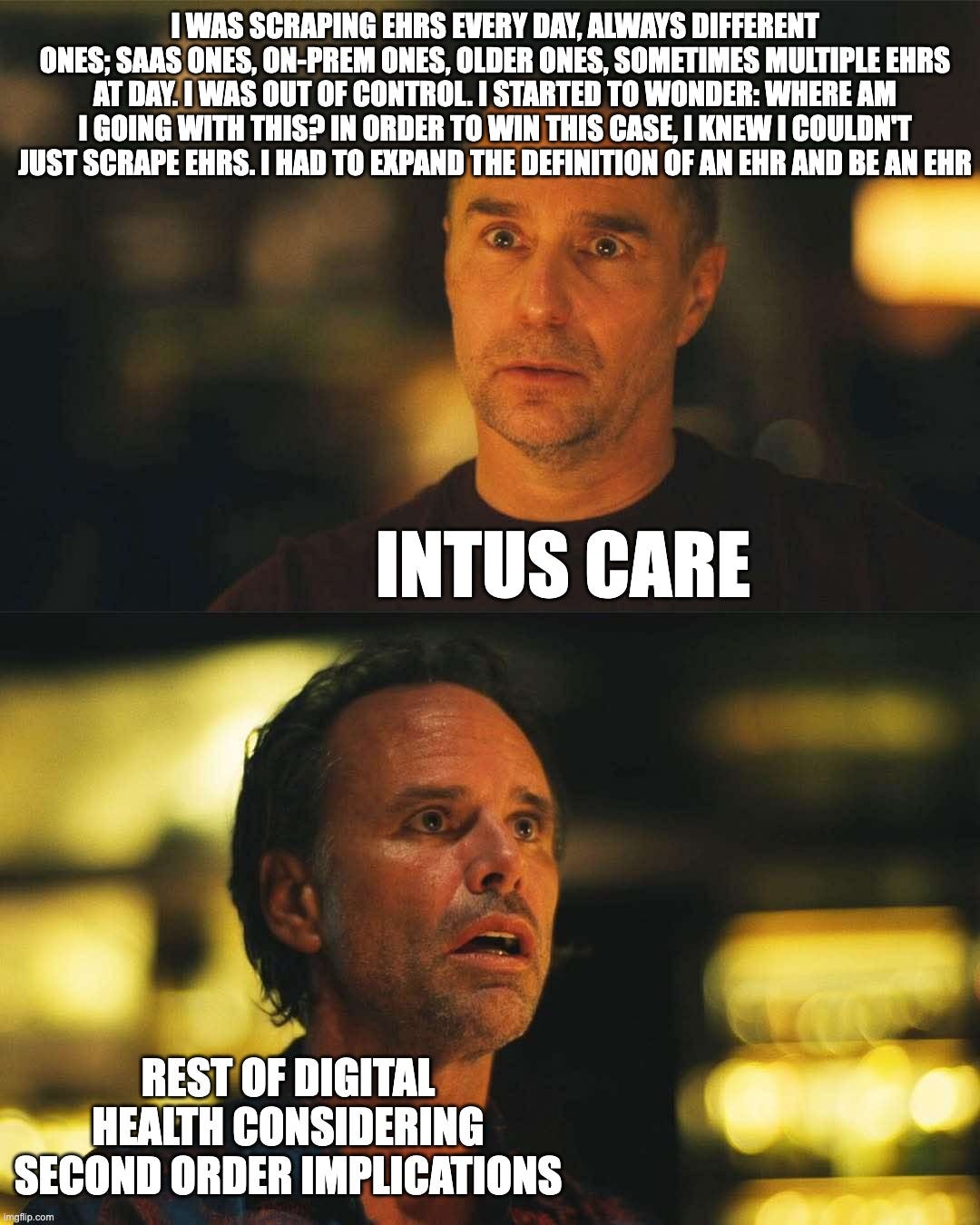Monthly Review - April's Art of the Deal
Epic's vibe change, the USCDI gap, and the expanding weaponization of information blocking
We’re hiring at HTD Health!
Hello readers! Has it been a month or a year since we last spoke? The rollercoaster of 2025 continues its wild ride, with policy shifts and economic fluctuations perfectly mirroring our era of breakneck AI advancement. This spring is all gas, no brakes — we've entered a landscape defined by tariffs, market volatility, and "the art of the deal."
The True Art of the Deal in Tech
In the tech world, the parallel art of the deal isn't about haphazard trade wars or outright grift but rather about strategic partnerships (though these are often equally poorly structured). The title "Partnerships" spans an enormous range of actual responsibilities, from glorified junior BDR to de facto head of strategy, depending on the organization you're engaging with.
The confusion extends beyond titles to the very nature of partnership functions. In some organizations, partnerships operate as an extension of sales, focused primarily on channel revenue. In others, they serve as a product development catalyst, identifying integration opportunities. And in yet others, partnerships function as a quasi-corporate development arm, scouting for potential acquisitions disguised as collaboration.
This ambiguity leads to meeting roulette. Will the "partnership opportunities" be speaking with anyone from a fresh college graduate tasked with filling a CRM or drilling into win-wins with a seasoned executive with decision-making authority over eight-figure budgets? The variance is staggering.
This definitional chaos means that even before discussing specific partnership models, you're often navigating a labyrinth of mismatched expectations. One organization might envision a simple logo exchange while the other is planning for deep technical integration requiring months of engineering resources.
I am not in partnerships. I am not a seasoned corporate development team member. But I sure as hell will take a crack at providing my simple personal taxonomy of partnership archetypes for you all to sort and parse the signal from the noise.
Referrals: The most basic form where you refer clients to each other. These typically only work when there's consistent client overlap and clear mutual benefit. These are low effort but without financial incentives, these often fizzle out - people just forget. They're low-effort to establish but equally low-commitment.
Comarketing: These partnerships involve sharing marketing resources, audiences, and occasionally brand equity. While they can effectively expand awareness, they rarely drive direct revenue unless structured around dedicated campaigns with concrete objectives, measurable outcomes and attribution mechanisms, and joint value propositions that resonate with both audiences.
Many comarketing efforts increase visibility but fail to convert that attention into actual revenue. There's often a big gap between making people aware of your business and actually getting them to spend money with you.
Professional services: In these arrangements, you become a preferred vendor or services partner in another company's network, helping them address segments or capabilities they can't efficiently service. These can work (we do them frequently with infrastructure companies to take the low margin of services delivery while they get the nice, clean SaaS revenue), but only if there's a clear path to client introductions and the partner has actual influence over purchasing decisions. Success also requires tight operational alignment, ensuring handoffs and delivery experiences remain seamless for the end client.
Cobuilding: These partnerships involve jointly developing products or service offerings that leverage both companies' core strengths. They require:
Significant resource investment from both parties
Clear governance and decision-making frameworks
Alignment on IP ownership and commercialization
Shared risk and reward structures
When successful, these partnerships can create unique offerings impossible for either company to develop independently. You need look no further than Epic’s Workshop program for the fruits of such arrangements. However, they also face the highest coordination costs and potential for misalignment.
Differentiated cornered resources: The rarest and potentially most valuable partnerships provide exclusive access to something inherently valuable - proprietary data, unique technology, or privileged distribution channels that competitors can't easily replicate. These partnerships create genuine competitive moats, deliver compounding advantages over time, and often evolve into deeper strategic relationships. However, they are inherently and innately bespoke unicorns. Maintaining exclusivity with such wild beasts becomes increasingly challenging as markets evolve, making these partnerships difficult to sustain once found and created.
Partnership Overload
I don’t know you specifically, reader, but I do know you in a general sense. Based solely on the (fairly paltry) metrics and analytics of this platform, you are likely a US-based (but possibly international) participant, contributor, competitor, aficionado, or voyeur of the most beautiful and frustrating of technology verticals, digital health. You are strong, smart, and independent, who many would posit as non-commoditized in nature.
And thus, it is hopefully readily apparent to you, but you are not a goddamn Pokemon. Your potential partner is not Ash Ketchum. If a partner is trying to catch them all, it should be at least a yellow flag to you. The fact that someone's highlighting you'd be partner #714 rather than focusing on specific mutual value creation opportunities speaks volumes. It suggests a strategy of accumulation over intention, of quantity over quality, of logos over logic.
There are well-designed ecosystems to join. There are vendors who have designed true platforms to build on. But such paved paths come with costs, with less differentiated, pre-ordained roles to play. The established partner programs offer visibility but often bind you to their way of doing things - their APIs, their pricing models, their approval processes. You trade autonomy for access, differentiation for distribution.
The Partnership Paradox
The harsh reality is that while partnerships offer tremendous upside potential, they have a remarkably high failure rate. They're uniquely challenging because they require:
Continuously aligned business objectives that resist the natural drift that occurs over time
Sustained organizational commitment that survives quarterly priorities and leadership changes
Internal champions who remain engaged despite competing demands on their time
Transparent incentives making the ongoing effort worthwhile for all parties
Clear executive sponsorship that can resolve conflicts and remove obstacles
Balanced value exchange where neither party feels they're giving more than they receive
Practical operational integration that reduces friction in day-to-day collaboration
It’s not the waste of time and effort that’s most painful - it’s the opportunity cost. Hours spent in fruitless partnership meetings are hours not spent on product development, direct sales, or other high-leverage activities with more predictable returns.
In this era and landscape of ambiguity and high failure rates, discernment is your greatest asset. Choose your partnerships deliberately, execute them thoughtfully, and don't hesitate to walk away when the signs point to misalignment. Your time and resources are too valuable to waste on partnerships that exist only in name.
Here is April’s monthly review. As a reminder, this is a regular round-up of various short(er) form content on social media (LinkedIn with a smattering of reposting to Twitter) is to surface things you may have missed across regulation, litigation, interoperability, and beyond.
Regulatory:
Information Blocking as Proactive Antitrust: Unlike traditional antitrust approaches that address market dominance reactively, information blocking functions as a proactive antitrust tool that applies equally to market leaders and upstarts. The RTMS v. PCC case highlights this dynamic, as PCC faced consequences for behavior that could be deemed anticompetitive without requiring proof of market dominance. Paradoxically, the compliance burden may actually accelerate EHR market consolidation rather than fragmenting it, as smaller vendors struggle to meet the regulatory requirements.
EHR Vendors’ Information Blocking Risk: With the appeals court decision in RTMS v. PCC emboldening application developers, several EHR vendors (such as Epic, eClinicalWorks, PracticeFusion, and Wellsky) face heightened risk of information blocking complaints. Screen scraping disruptions (like eCW's Cloudflare changes) further expose these vendors to potential litigation under the broad interpretation of information blocking rules.
The USCDI Gap: The "30% problem" revealed in the RTMS v. PCC case illustrates why USCDI FHIR APIs alone aren't sufficient. The standardized dataset works reasonably well for basic health information exchange but falls far short for ancillary applications needing more comprehensive data. A first-principles redesign would require subscriptions for events like appointments and admissions, core clinical and administrative data pull capabilities, writeback functionality, and synchronization of metadata - all currently beyond USCDI's scope.
TEFCA at the Crossroads: Despite initial rumors of contract cancellations that created uncertainty, TEFCA continues to gain momentum with Epic and MEDITECH migrations underway and athenahealth's commitment to mid-year adoption. Early successes in public health exchange and Individual Access Services testing demonstrate real progress. However, challenges remain around governance representation, patient transparency, and establishing sustainable network effects. The next few months will determine whether TEFCA's network effects accelerate or stall under the new administration.
Court cases:
No Early Discovery in Particle v. Epic: Judge Buchwald definitively shut down Particle's attempt to challenge the oral stay on discovery while Epic's motion to dismiss is pending. Despite this setback, Particle's path forward remains clear - survive the motion to dismiss and proceed to discovery, where they might uncover internal Epic communications about competitive strategies that could support their case. The firm judicial response reinforces the procedural discipline courts expect in these high-stakes healthcare technology disputes.
PointClickCare’s En Banc Request: PCC petitioned for the full Fourth Circuit to review their case, arguing the panel misinterpreted the Manner Exception, improperly allowed private enforcement of the Cures Act, and incorrectly placed the burden of proof. While a procedurally appropriate step, the petition appears to be a long shot as it largely rehashes arguments already addressed in the appeal decision. The request focuses on the case's significance as the first major information blocking litigation, potentially affecting all Americans' health record access.
EHR Association’s Second Amicus Brief: The EHRA, joined by the American Hospital Association, filed a brief supporting PCC's en banc petition. They argue the appellate decision creates an unreasonable negotiation burden for healthcare organizations receiving countless information requests annually. Their position on the Manner Exception claims it was specifically designed to allow standardized alternatives rather than custom solutions, though this interpretation conveniently sidesteps the "missing 70%" of data not covered by standards like USCDI.
Information Blocking and Community Connect: A novel angle on information blocking involves Epic Community Connect affiliates potentially wielding the rule against their host organizations. Smaller providers might break free from centralized technology governance by claiming restriction of preferred technologies constitutes information blocking. This could fundamentally alter the power dynamic in these relationships, empowering smaller practices on shared EHR instances to make independent technology choices despite the hub organization's preferences.
Intus Care and the Broad Aperture of Information Blocking: In a case paralleling RTMS v. PCC, Intus Care's lawsuit against RTZ shows how broadly information blocking regulations might reach. After RTZ blocked Intus from scraping data, Intus initially claimed RTZ qualified as a Health Information Network due to connections with labs and pharmacies - a designation that would dramatically expand the scope of regulated "actors." While the certified health IT developer angle will likely fail (RTZ's certification lapsed years ago), the HIN approach could potentially classify numerous health tech vendors as subject to information blocking rules.
The Fourth Circuit Denies PointClickCare’s En Banc Petition: The long shot from PCC, the EHR Association and AHA fails. The preliminary injunction (and associated precedent) stands and we continue back to the district court for the fuller trial.
EHRs:
EHR Association’s Bad Bulk FHIR Take: The EHR Association's recent blog post proposing to remove Bulk FHIR from certification requirements misses the mark. Rather than recognizing "limited adoption" as a consequence of vendor implementations that are nearly unusable, the Association overlooks the real issues: limits on group size, lack of documentation, no dynamic groups, and missing _since parameters. The post demonstrates the disconnect between regulatory objectives and practical implementation of critical interoperability infrastructure.
Oracle’s Cybersecurity Incident: A reported cybersecurity incident at Oracle resulted in a nationwide outage of Veteran's Affairs sites running on Oracle systems. While details remained limited initially, the timing and impact raised questions about resilience and security measures, particularly for critical healthcare infrastructure like VA facilities that depend on reliable system performance.
New Epic Logos: Epic trademarked two new heart-themed logos last month, prompting some fun guesses about their actual use and meaning (they are related to Epic’s AI offerings in reality).
Epic on Twitter: After years of dormancy, Epic activated their X (Twitter) and Bluesky accounts, sparking industry surprise. Their initial "sir, this is a Wendy's" tone included playfully dunking on industry commentators (like me). This social presence, coupled with other outreach initiatives, suggests a strategic shift toward more external engagement, potentially driven by the specter of antitrust issues, information blocking, and a desire to soften their image under new leadership.
Epic Q1 Toolbox Update: Epic expanded their Toolbox categories with several notable additions including Anesthesia Infusion Injectable Hardware, Digital Pathology, Health Information Service Provider, and Outpatient CDI, showing Epic's maturing approach to third-party integrations and standards utilization.
Epic’s Meiji Era: Like Japan's historic opening to the world after centuries of isolation, Epic is turning outward with unprecedented initiatives: the Open@Epic developer conference announcement, a new Twitter presence, and executive podcast appearances. These changes signal a significant cultural shift, possibly driven by leadership transition preparation or recognition of the competitive necessity to engage the broader developer ecosystem. Plus, we get a fun meme out of it:
EHRs’ Interoperability Progress: I often point out the problems - the court cases, the failures in regulation, and the anticompetitive behaviors of incumbents. So I want to showcase more of our industries’ wins. To that extent, several EHRs are making substantial progress beyond regulatory minimums for FHIR and beyond.
Industry Analysis
The State of Interoperability and HIE Today: My HIMSS HIE forum keynote explored how ubiquity trumps technical advantages in network adoption. While AI is transforming the interoperability landscape by reducing analog network costs and enabling digital networks with analog-like flexibility, the industry still struggles with competing standards and fragmented exchange models.
The Principal-Agent RPA Impasse: Applications are increasingly turning to RPA and screen scraping EHRs instead of traditional integration, especially for smaller practices where decision-makers control budget and can sign BAAs directly. While technically feasible for enterprises too, the principal-agent problem creates barriers - clinicians who want innovative applications lack authority to approve RPA solutions, while security teams reflexively block such approaches.
A Second Chance at Clinical Decision Support: The ambient copilot trend offers an opportunity to reimagine clinical decision support, escaping the alert fatigue problems of first-generation implementations. With the ambient workflow already incorporating a natural pause to review and approve AI-suggested documentation, this moment creates an opening for surfacing evidence-based recommendations, care gaps, and clinical trials in context. However, we risk creating a new form of "approval fatigue" if these tools simply shift clinician time from documentation to supervision tasks.
What Bill Clinton Took from Us: Simply put, Richard Scarry is the GOAT.
The Meaningful Use Counterfactual: The common trope that Meaningful Use irrevocably distorted the EHR market doesn't hold up to scrutiny. Most MU criteria fall into either basic EHR functionality or infrastructure capabilities for public health and exchange that would have emerged regardless. While some requirements like portal utilization thresholds proved problematic, international comparisons show remarkably similar EHR features and adoption curves across diverse regulatory environments.
Cross-industry Comparisons:
EHRs as described by Tidemark’s Vertical SaaS Principles: David Yuan and Tidemark put out some of the best thinking about vertical software, period. I’m consistently surprised how many operators in healthcare don’t know about it or incorporate it into their thinking. Along those lines, their Vertical SaaS Knowledge Project perfectly maps Epic's strategic evolution.
The Stunning Similarity of Car Dealers and Healthcare Providers: Automotive dealer management systems represent the only other vertical with regulations comparable to healthcare's information blocking rules. Arizona's HB 2418 and similar state laws grant auto dealers significant data access rights and prevent DMS vendors from using technical barriers to restrict data flow. The incumbent systems (Reynolds & Reynolds, CDK) challenged these laws based on copyright claims and lost, paralleling healthcare's struggles. While dealers operate under state-by-state patchwork regulations, healthcare providers benefit from uniform federal standards, giving healthcare application developers unique leverage against entrenched systems.
AI Scribe’s Twin Pressures: Matt Brown is another great thinker in vertical software (although he comes at it from a fintech angle). His analysis applied to healthcare reveals AI scribes face dual market challenges: intelligence commoditization as AI capabilities become ubiquitous, and inevitable bundling by systems of record. The most strategic scribes are positioning for this reality by focusing on specific segments and pursuing deeper technical integration.
The Upside of Agents: Autonomous agents represent healthcare's most disruptive opportunity, fundamentally reframing the TAM from "capturing software spend" to "replacing labor costs." While traditional software (including copilots) claims portions of the $30-40 billion annual healthcare IT spend, agents can target hundreds of billions in clinical and administrative labor costs.
The Four Categories of B2B Software: At the risk of generalizing, all B2B software falls roughly into four buckets: systems of record (source-of-truth platforms with high switching costs), point solutions (specialized applications orbiting the system of record), infrastructure (tools for builders), and networks (applications connecting multiple parties). From an investment perspective, point solutions face persistent challenges without a path to evolve into one of the other categories. Only network effects and switching costs provide lasting moats, making systems of record and networks particularly resilient business models when successfully established.
Automotive DMS Antitrust: The parallels between healthcare and automotive dealer systems extend to antitrust disputes. Tekion Corp (founded by ex-Tesla team members) is suing CDK Global over alleged anticompetitive practices, mirroring Infosys's counterclaim against Cognizant and Particle's lawsuit against Epic. Like EHRs controlling healthcare data, CDK leverages dealer data access to potentially block competitors and charge excessive fees. These parallel legal battles across different verticals reveal how system-of-record platforms can leverage data control into market dominance, prompting similar regulatory and legal countermeasures.
Other News:
The Tells of AI Slop: “It's not about avoiding AI assistance — it's about creating genuine value beyond algorithms.” Social networks are flooded with "AI slop" containing telltale signs: excessive emdashes (—), "It's not about X, it's about Y" phrasing (ahem), bullet-point lists, and summary without insight. This is not to hate on the emdash (please use it as much as you like). It’s simply to say that AI raises the content floor, making original thought more valuable. Rather than policing AI use, we should focus on adding human perspective that machines can't replicate.
Epic Alumni Slack Community Update: The Epic Alumni Slack community has continued to grow to nearly 800 active members across 41 states and 13 countries. It’s fun, it’s good for hiring or finding jobs, and there’s interesting banter about all the twists and turns of healthcare technology.
NYC Sales/Solutions Engineer: A stellar former colleague with dual finance and engineering backgrounds is exploring NYC-based opportunities in forward-deployed engineering, sales engineering, or solutions architecture.
The Dubious Nature of Brain Picking: I’m never going to live this one down and will forever be seen as some recluse, but the phrase "brain picking" often signals a one-sided extraction of value without context or reciprocity. Unlike more transparent requests for advice or perspective, "brain picking" creates social pressure to comply through faux casualness while masking the extraction intent. If you’re asking people for advice and help, just come open and willing to share, be transparent, and make sure to follow up down the line.
Digital Health in Portland: The Portland digital health and health tech community gathering at Wayfinder Beer was a blast. Make sure to sign up for the next one here.
The Pain of Legal Tools: Following legal cases requires navigating frustratingly archaic systems like PACER, which charges substantial fees even for checking case status with no updates. The lack of affordable tools to monitor filings, search across jurisdictions, or access audio recordings creates significant information barriers. If anyone knows of any solutions here, I’d love to hear about them.
External Media:
How to get access to the future of healthcare interoperability (Arcadia at HIMSS): Aneesh Chopra invited me to join him at their booth at HIMSS. We covered a lot of ground, but the most exciting initiative we discussed was 'Neighborhood Watch' - a community-led effort to test FHIR API endpoints across certified EHRs. Despite 75% of providers being on interoperability networks, many certified APIs don't actually work in real-world settings. This collaborative approach aims to bring transparency and accountability without being punitive, ultimately helping vendors fix issues before they face information blocking fines or certification problems. More to come here soon.
AI Rounds Episode 3 (Innovaccer): Our latest AI Rounds episode went through several key healthcare AI topics, including the landmark RTMS v. PointClickCare ruling on information blocking. The conversation also covered the expanding accessibility of AI agents to EHR data, Oracle's Wikipedia-focused blog posts criticizing Epic, and the evolution of AI scribes.
Thriving in an Epic Dominated Marketplace (The Eye of the Needle): I hopped on with Pam and talked about how to succeed in Epic's ecosystem by delivering "10x value" rather than trying to compete directly. We discussed how the information blocking regulations give companies legal leverage when they have provider buy-in, and how future technology shifts like AI might eventually challenge Epic's dominance. The key takeaway: focus on solving real provider problems with overwhelming value instead of battling the 10,000-pound gorilla head-on.
Epic Systems (Acquired): Acquired, arguably the most popular tech oriented podcast out there, decided to cover Epic. I got the chance to chat a bit with Ben, one of the hosts, in advance. Their coverage is excellent and a must-listen for anyone wanting to understand the company’s dominance.
Swaay.Health Article of the Year: My article from last fall, “An Epic Saga: The Origin Story” won an award at the annual conference for Swaay.health, the leading healthcare marketing community.
Posts I Liked:
A Good Meme Roast (Brad Thorson): My colleague and good friend absolutely roasted me. Have to appreciate a good meme, though.
TEFCA and Carequality (Lisa Bari): Good update from Lisa on the state of our national health information networks in these times of administrative uncertainty.
LLM Evals for SNAP (Josh Kelly): Josh is one of the smartest people I’ve ever worked with and well worth a follow. The article he highlights is fascinating, cutting-edge stuff.













Thanks for sharing my piece on building evals for SNAP! Sharing that I also cross-post many of those to my personal Substack here in addition to our company blog: https://daveguarino.substack.com/
... just imagine if there were - I dunno - some national standards for interop ;-)
All these brittle connections are both a legal and technical nightmare. Or as Dr. Brailer once said: "We've created the Frankenstein monster I was most afraid of."